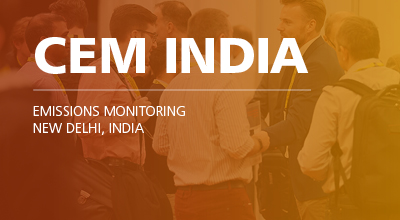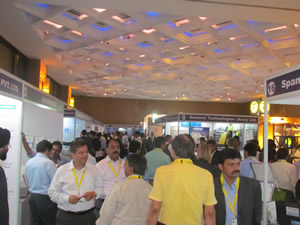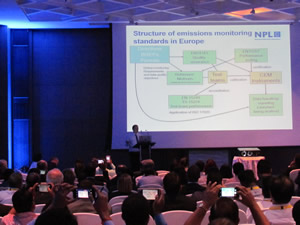


“Delegates came from all over India and from over 40 other countries, as part of an initiative to help Indian industries combat air pollution with effective continuous emissions monitoring systems (CEMS). It is only by monitoring emissions continually that process operators are able to implement effective abatement and process optimisation measures whilst demonstrating compliance with emissions limits,” Marcus adds.
CEM India was organised by ILM Exhibitions working with a scientific committee of experts from industry, the Source Testing Association (UK), NPL (UK), the Federation of Indian Chambers of Commerce and Industry (FCCI), TÜV (Germany) and the Indian Centre for Science and Environment (CSE). CEM 2017 was created to support a major programme of emissions reduction that is currently underway in India. Effective and reliable monitoring is crucial to the implementation of this plan, and the event provided those within the affected industrial sectors with an opportunity to learn about the latest techniques, methods, standards and technologies.
CSE launched a new CEMS technical guidance manual at CEM India 2017. Their Deputy Director General, Mr. Chandra Bhushan, said: “The manual provides detailed technical guidance on CEMS in India, including technology options, their suitability for an industry and the kind of certification, calibration and verification required. The manual also explains data acquisition, handing and the compliance check mechanisms that need to be undertaken to ensure the credibility of the system. CEMS regulations and best practices in Europe, USA and those proposed in India, are also discussed in the manual. We, at CSE, strongly believe that the guidance manual will be useful for those willing to take adequate steps towards reducing emissions. It will help in the skills and knowledge development of stakeholders and serve as an informative guide to inspire proper and successful implementation of CEMS in India.”
As one of the world's fastest growing economies and with the third highest level of carbon dioxide emissions, India has a vital role to play in the fight against climate change and air pollution. Recognising the critical role of monitoring in emissions management, the Central Pollution Control Board (CPCB) has adopted Continuous Emissions Monitoring Systems (CEMS) as the preferred method for measuring industrial emissions in India. The CPCB has initially directed plants in 17 categories of the most polluting industries to install CEMS for real-time monitoring and compliance with regulatory emissions limits.
The industry sectors affected by these new requirements include Aluminium, Cement, Chlor Alkali, Copper, Distilleries, Dying, Fertilizers, Iron and Steel, Oil Refineries, Pesticides, Petrochemical Plants, Pharmaceuticals, Power Plants, Pulp and Paper Mills, Sugar, Tanneries and Zinc. The parameters specified for continuous monitoring include Particulates, Hydrogen Fluoride, Ammonia, Sulphur D
ioxide, NOx, Chlorine, Hydrogen Chloride, Carbon Dioxide and Carbon Monoxide.
CEM India Conference
The conference was inaugurated by Mr. A. Sudhakar, Member Secretary, CPCB; Mr. Chandra Bhushan, Deputy Director General, CSE and Mr. William Averdieck, Chairman of the Source Testing Association.
The main themes of the conference included Indian Regulations 
and Monitoring Guidelines, Manual Stack Monitoring, Continuous Emission Monitoring, Calibration and Quality Control, Monitoring Techniques for: Particulates; Combustion gases including NOx, SO2, CO and CO2, trace sp
ecies such as metals, mercury and dioxins, and Data Management. A number of industrial case studies were also described in detail. Abstracts for all of the presentations are available at www.CEMIndia.com.
The Conference provided high level speakers from India, including senior representatives from the Ministry of Environment, Forest & Climate Change, and the Central Pollution Control Board. In addition,
there were presentations from globally respected experts from Austria, Finland, France, Germany, India, Italy, Israel, Netherlands, Russian Federation, UK and USA.
CEM India Exhibition
Featuring over 50 of the world’s leading providers of emissions monitoring equipment, the CEM India exhibition provided visitors with an opportunity to view the latest equipment and technologies available from the world’s leading providers. It also enabled visitors to discuss their applications with experienced industry professionals in order to find effective solutions to their monitoring goals.
The equipment on show included sampling and conditioning devices, continuous monitors, portable monitors, bag leak detectors and calibration gases. The monitors covered a wide range of technologies including FTIR, FID, PID, NDIR, CVAF, GCMS, UV spectrometry, chemiluminescence, laser gas analysers and particulate monitors, amongst others.
Summarising, William Averdieck said: “CEM India 2017 was perfectly timed. Pollution control in India is following a path that has been taken by many countries, so this event provided a fantastic opportunity for experts from around the world to share their knowledge and experience in the implementation of effective emissions monitoring.
“The event was extremely well attended with over 700 participants, but clearly, these were the people that are looking to make environmental improvement. Nevertheless, the overwhelming feedback from the event was that it should be repeated, so I very much hope that there will be another CEM India, perhaps in 2019.
“Obviously these are early days in the implementation of CEMS across India and there are many challenges ahead, but there was a wonderful energy at the Conference and it was very gratifying to see the enthusiasm with which delegates engaged with the new challenge of adopting CEMS and finding practical, proven monitoring solutions. The presentations were technical, solution-orientated and non-commercial, so this felt like a cohesive event at which everyone came together in the pursuit of a common goal.”